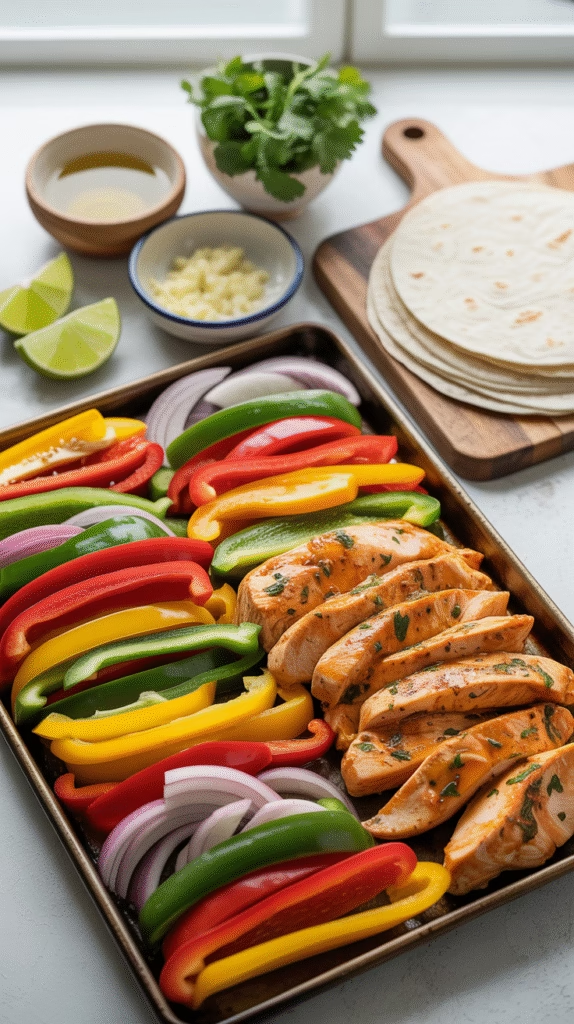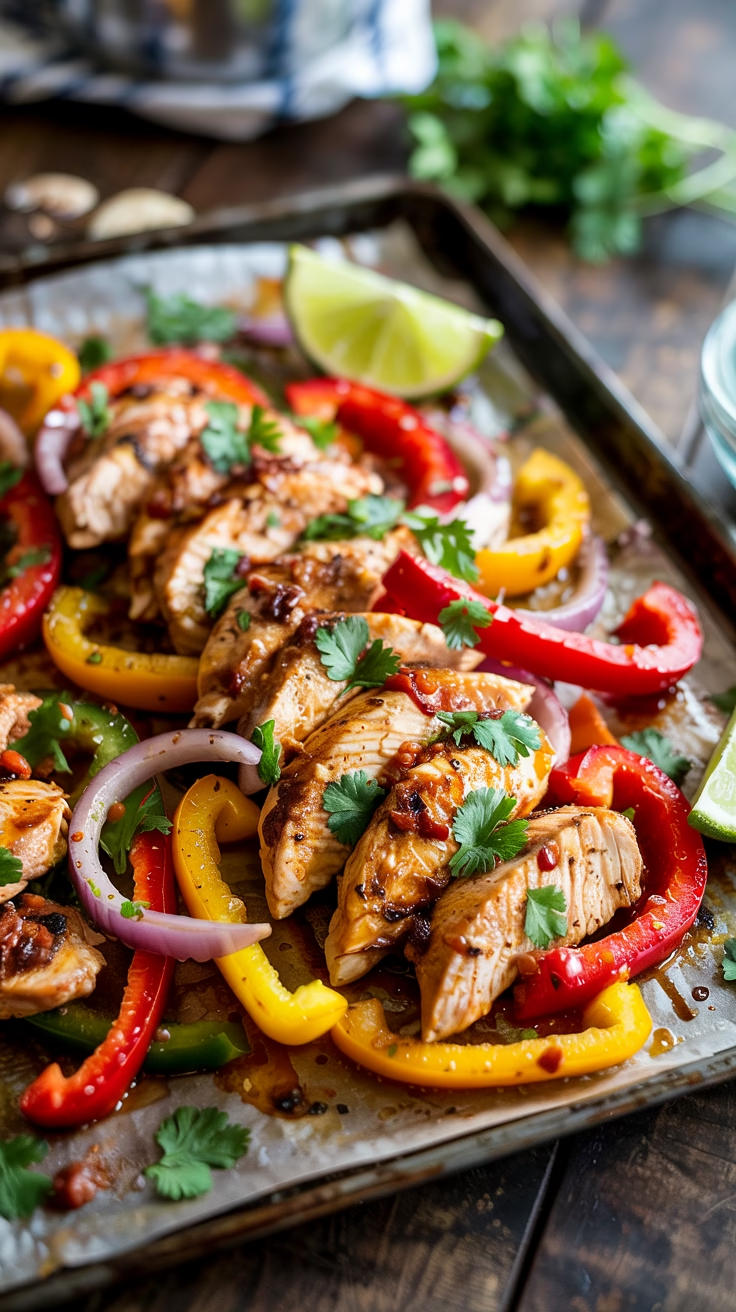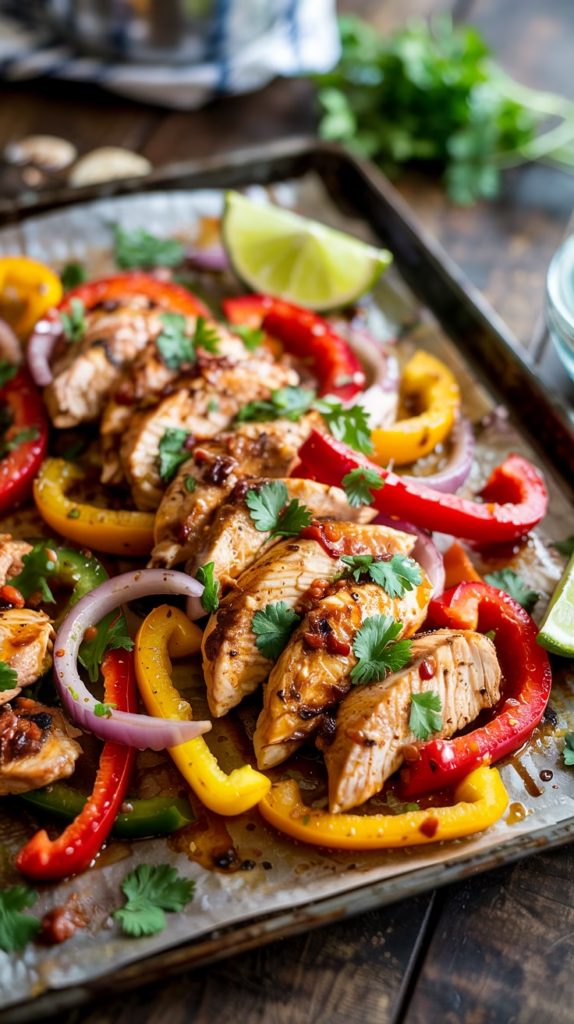Why You’ll Love This Recipe
After testing dozens of variations, I can confidently say this is the most reliable method for perfect fajitas every time. Here’s why this recipe stands out:
1. Foolproof Cooking Method
Unlike stovetop fajitas where you’re constantly stirring and worrying about overcooking, the sheet pan method is remarkably forgiving. The even heat of the oven ensures everything cooks uniformly, while the broiler at the end gives you that signature char without any fuss.
2. Customizable to Any Taste
My family has different spice preferences – I like mine with some heat, while my kids prefer milder flavors. This recipe accommodates everyone beautifully. The base seasoning is flavorful but not spicy, making it easy to adjust the heat level with add-ons.
3. Meal Prep Champion
These fajitas taste just as good reheated as they do fresh, making them perfect for meal prep. I often double the recipe on Sundays to have ready-to-go protein and veggies for quick lunches throughout the week.
4. One Pan Wonder
With only one pan to clean (especially if you line it with parchment paper), cleanup is a breeze. This has become my go-to recipe when I’m too tired for elaborate cooking but still want something delicious and homemade.

Ingredients Breakdown
The Chicken: Thighs vs. Breasts
After extensive testing, I’ve found boneless, skinless chicken thighs work best for sheet pan fajitas. Their higher fat content keeps them juicy during roasting, and they’re more forgiving if slightly overcooked. However, breasts work well too if you prefer leaner meat – just be careful not to overcook them.
Pro Tip: For extra tender chicken, try velveting your chicken before marinating. Mix 1 tablespoon cornstarch with 1 tablespoon water and toss with the chicken before adding the other marinade ingredients. This Chinese cooking technique creates an incredibly tender texture.
The Vegetables: More Than Just Peppers and Onions
While traditional fajitas stick to bell peppers and onions, don’t be afraid to experiment. Some of my favorite additions include:
- Sliced portobello mushrooms for an earthy depth
- Zucchini or yellow squash for extra veggies
- Thinly sliced fennel for a subtle licorice note
- Poblano peppers for a milder heat option
The Marinade: Flavor Science
The acid in the lime juice helps tenderize the chicken while brightening all the flavors. For maximum flavor penetration, I recommend marinating for at least 30 minutes, though even 15 minutes makes a noticeable difference. If you have time, marinating overnight will give you incredibly flavorful results.
Secret Ingredient: A teaspoon of fish sauce in the marinade adds umami depth without making the fajitas taste fishy. It’s my not-so-secret weapon for boosting flavor in all my Mexican dishes.

Step-by-Step Cooking Instructions
1. Preparation: The Key to Success
Proper prep makes the cooking process seamless. Here’s my recommended order:
- Make the seasoning blend
- Juice the limes
- Slice the vegetables
- Cut the chicken
- Combine everything for marinating
Knife Skills Tip: For even cooking, try to cut all your vegetables to about the same thickness (about 1/4-inch strips). This ensures they’ll roast evenly rather than some pieces burning while others remain undercooked.
2. Marinating: Patience Pays Off
While you can cook immediately after mixing, I’ve found the flavor difference between 15 minutes and 30 minutes of marinating is significant. If possible, let it sit while you:
- Preheat the oven
- Set the table
- Prepare any sides or toppings
- Enjoy a well-deserved break
3. Roasting: The Perfect Technique
The roasting process is where the magic happens. Here’s what’s occurring at each stage:
- First 10 minutes: The chicken begins to cook through while the vegetables start to soften
- Next 10 minutes: The chicken develops color while the vegetables begin to caramelize
- Final 5 minutes (broiling): Everything gets those beautiful charred edges that add so much flavor
Oven Variation Note: Every oven is different. If you notice your chicken browning too quickly, you can tent it with foil or reduce the temperature slightly. The key is getting the chicken to 165°F internally while achieving nicely caramelized vegetables.
Serving Suggestions & Presentation
The Tortilla Matters
While flour tortillas are traditional, don’t limit yourself. Some delicious alternatives:
- Corn tortillas for authentic flavor (warm them directly over a gas flame for extra character)
- Lettuce wraps for a low-carb option
- Cheese shells for keto dieters (bake piles of shredded cheese until melted, then drape over a rolling pin to cool into taco shapes)
Toppings Bar Ideas
Setting up a fajita toppings bar turns dinner into an interactive experience. Some crowd-pleasers:
- Creamy elements: Guacamole, sour cream, Mexican crema
- Fresh accents: Pico de gallo, chopped cilantro, lime wedges
- Crunchy textures: Shredded cabbage, radish slices
- Cheese options: Queso fresco, cotija, shredded Monterey Jack
Plating for Maximum Appeal
For Instagram-worthy presentation:
- Pile the fajita mixture slightly off-center on a warm platter
- Arrange colorful toppings around the edges
- Garnish with a generous sprinkle of fresh cilantro
- Add lime wedges for a pop of color
- Serve with tortillas in a separate basket to prevent sogginess
Meal Prep & Storage Tips
Make-Ahead Strategies
- Vegetable Prep: Slice peppers and onions up to 3 days in advance
- Chicken Prep: Marinate chicken overnight for maximum flavor
- Full Meal Prep: Cook completely, then portion into meal prep containers
Reheating for Best Results
To maintain texture when reheating:
- Oven Method (Best): 350°F for 10-15 minutes
- Skillet Method: Medium heat with a splash of water to prevent drying
- Microwave (Quick Fix): Cover with a damp paper towel to retain moisture
Freezing Instructions
While best fresh, you can freeze cooked fajitas:
- Cool completely
- Portion into freezer bags, removing excess air
- Label with date
- Freeze for up to 2 months
- Thaw overnight in refrigerator before reheating

Nutritional Information & Dietary Adaptations
Health Benefits
This dish packs nutritional punch:
- Chicken: High-quality protein
- Bell Peppers: Excellent source of vitamin C
- Onions: Contain antioxidants and anti-inflammatory compounds
- Olive Oil: Heart-healthy fats
Dietary Adaptations
- Gluten-Free: Use corn tortillas and verify seasoning
- Dairy-Free: Skip cheese and sour cream
- Whole30/Paleo: Omit beans and dairy
- Keto: Serve over cauliflower rice
Troubleshooting Common Issues
Problem: Soggy Vegetables
Solution:
- Make sure oven is fully preheated
- Don’t overcrowd the pan
- Pat vegetables dry before roasting
- Increase roasting temperature by 25°F
Problem: Dry Chicken
Solution:
- Use thighs instead of breasts
- Don’t overcook – use a meat thermometer
- Increase marinating time
- Try the velveting technique mentioned earlier
Problem: Bland Flavor
Solution:
- Toast spices before making seasoning blend
- Increase salt slightly
- Add acid (more lime juice) at the end
- Try the fish sauce trick mentioned earlier
Final Thoughts
These Sheet Pan Chicken Fajitas epitomize all things I adore about home cooking: big flavors, low fuss, and endless adaptability that have saved many a weeknight meal for me at home and will do so for you. This recipe is easy, always works, and allows room for your own tweaks, but the main thing to remember is that great cooking isn’t perfect; it’s food that brings people together. So whether it’s a crazy Tuesday night or a relaxed weekend party, let me know how you make these Sheet Pan Chicken Fajitas yours.
